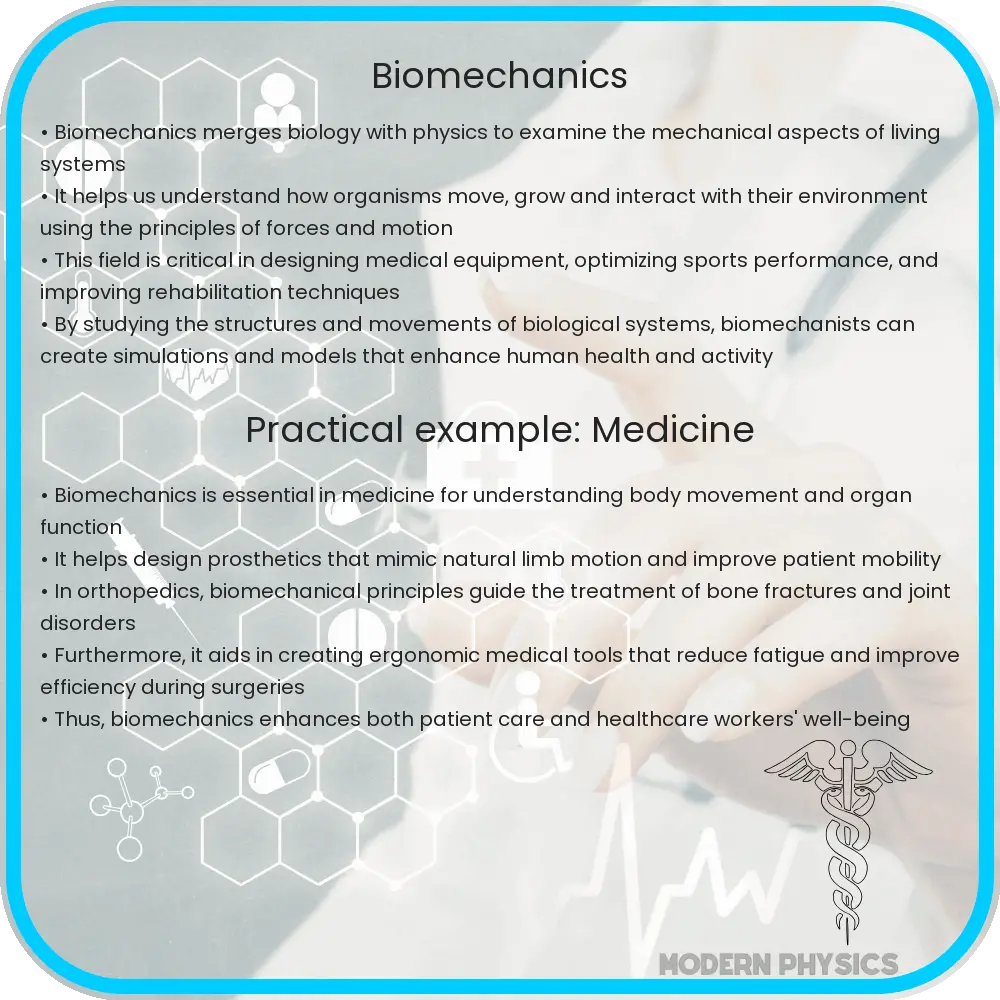Understanding biomechanics: the study of mechanical principles in living organisms, crucial for sports science and medical advancements.

Introduction to Biomechanics
Biomechanics is a fascinating subspecialty of physics that applies principles of mechanics to understand movements and forces in living organisms. At the intersection of biology and physics, it helps disclose the complex interplay between biological structures and mechanical forces. From the movement of cells to the dynamics of human movement, biomechanics is essential in fields such as sports science, orthopedics, and bioengineering.
Core Principles of Biomechanics
At the heart of biomechanics are several core principles derived primarily from classical mechanics:
- Force: All biomechanical interactions involve forces that act on biological tissues. These can be external (like gravity) or internal (muscular forces).
- Motion: Biomechanical studies often analyze the motion of bodies in response to applied forces, applying kinematics to describe motion without considering the forces that cause it, and kinetics to relate the motion to its causes.
- Equilibrium: Biological systems often strive for mechanical equilibrium, a state where no net force or moment causes movement.
- Elasticity: This property describes how biological tissues return to their original shape after deforming forces are removed.
Applications of Biomechanics
Biomechanics finds applications in numerous practical and theoretical areas, including:
- Sports science: Enhancing athletic performance and reducing injuries by analyzing athletes’ movements and optimizing their techniques.
- Medical fields: Designing more effective prosthetics, understanding the mechanics of injury, and improving surgical techniques.
- Robotics: Developing advanced robotics by mimicking biological movement patterns and mechanics for more natural and efficient robots.
- Ergonomics: Improving workplace design based on the study of human body mechanics to prevent occupational injuries.
Continuum Mechanics in Biomechanics
Continuum mechanics plays a critical role in biomechanics by describing the behavior of biological materials using continuum assumptions. Tissues are viewed as continuous matter rather than discrete, which simplifies the complex structures into manageable models. This approach is fundamental in computational biomechanics for simulating and analyzing biological structures under various mechanical loads. The key assumptions in continuum mechanics for biomechanics are:
- Material Homogeneity: Treating a complex material as uniformly composed throughout for easier analysis.
- Material Continuity: Assuming no gaps or discontinuities in the material, which may not always hold at smaller scales like the cellular level.
Mathematically, the behavior of these materials is often described by the stress (σ) and strain (ε) relationship, captured in the equation:
σ = E * ε
where E represents the modulus of elasticity, a measure of stiffness in materials. This relation is crucial in determining how much a material will deform under a given stress and is paramount in biomechanical engineering.
Future Trends in Biomechanics
The future of biomechanics looks bright with advancements in technology and interdisciplinary collaboration. Emerging trends include:
- Wearable Technology: Devices that monitor physiological signals and biomechanical data in real-time, empowering both athletes and everyday users to optimize their movements and prevent injuries.
- Personalized Medicine: Utilizing biomechanical analysis to customize treatments and rehabilitation programs based on individual biomechanical profiles.
- Biological Robotics: Creating robots with even more life-like functionalities by integrating biological components, such as muscle tissues or neural networks.
These advancements are not only enhancing our understanding of biological mechanics but also revolutionizing how we interact with and benefit from this knowledge.
Challenges in Biomechanics
Despite its immense potential, biomechanics faces several challenges:
- Complexity of Biological Systems: The sheer complexity and variability of biological systems make modeling and prediction difficult.
- Scaling: What works at one scale (e.g., cellular) may not apply at another (e.g., organ level), necessitating scale-specific studies and models.
- Ethical Considerations: As biomechanics intersects more with technology, ethical concerns about data privacy and bioethics become increasingly significant.
Conclusion
Biomechanics is a dynamic field that bridges physics and biology to provide deeper insights into the functioning of living organisms. By understanding mechanical properties and applying engineering principles, biomechanics improves lives through advancements in healthcare, sports, robotics, and ergonomics. The synergy between theoretical principles and practical applications propels ongoing research and innovation, addressing both the challenges and opportunities as the field evolves. As technology progresses, so too will the applications and accuracy of biomechanical studies, highlighting an exciting future for this integrative science.
